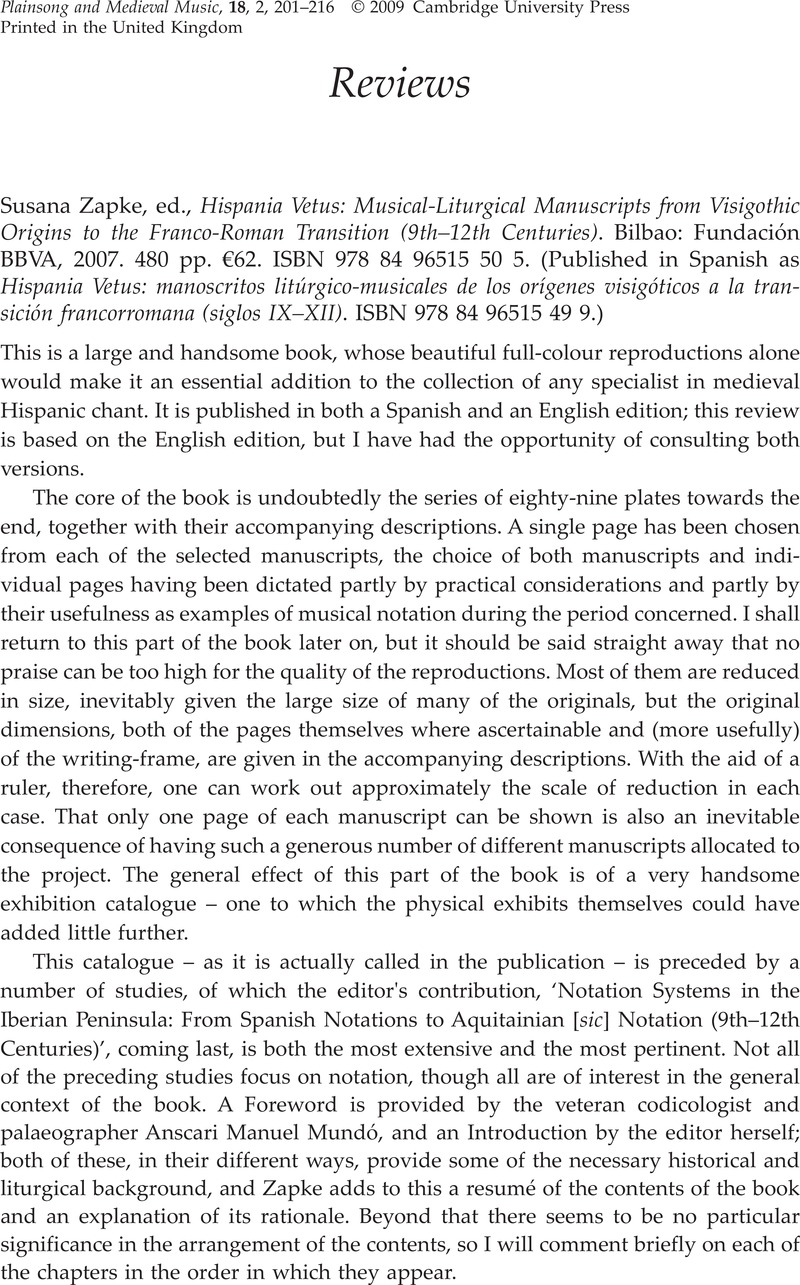Article contents
Susana Zapke, ed., Hispania Vetus: Musical-Liturgical Manuscripts from Visigothic Origins to the Franco-Roman Transition (9th–12th Centuries). Bilbao: Fundación BBVA, 2007. 480 pp. €62. ISBN 978 84 96515 50 5. (Published in Spanish as Hispania Vetus: manoscritos litúrgico-musicales de los orígenes visigóticos a la transición francorromana (siglos IX–XII). ISBN 978 84 96515 49 9.)
Published online by Cambridge University Press: 10 September 2009
Abstract

- Type
- Reviews
- Information
- Copyright
- Copyright © Cambridge University Press 2009
References
1 Isidori Hispalensis Episcopi Etymologiarum sive originum libri XX, ed. W. M. Lindsay (Oxford, 1911).
2 Michel Huglo, ‘Les diagrammes d'harmonique interpolés dans les manuscrits de la Musica Isidori’, Scriptorium, 48 (1994), 171–86 (reprinted in Huglo, Les anciens répertoires de plain-chant (Aldershot, 2004), art. IX.
3 There is of course the larger issue of the misuse of oblique cases in non-Carolingian liturgical sources, including the ‘dictionary’ forms of liturgical genres; but ‘A solis ortu cardine’ is in a category of its own, perhaps the result of a confusion with the psalm-verse ‘A solis ortu usque ad occasum’ (Ps. 112:3).
4 Don M. Randel, An Index to the Chant of the Mozarabic Rite (Princeton, 1973). I have identified nearly all of the Mozarabic chants reproduced in this book with the aid of Randel's index: the main outcome has been to confirm its high level of accuracy and to resolve most of the ambiguities in the present volume.
5 The standard of transcription is in general high; occasionally, however, other abbreviated rubrics have been misunderstood, and it is surprising to find an experienced palaeographer and liturgist misreading the cue ‘Iuda te lau[dabunt]’ as ‘Ludate [sic] lau’ (p. 304).
6 BL Add. MS 30851, ed. J. P. Gilson, The Mozarabic Psalter, Henry Bradshaw Society 30 (London, 1905); represented in this volume by a page of its hymnary; there are lacunae throughout the manuscript. The Breviarium gothicum edited by Lorenzana and reproduced in PL 86 also includes seventy-seven canticles, but the collection is not identical.
7 They are not, however, unidentifiable. Two hands, one ‘northern’ and one ‘Toletan’ are represented in this portion of the page. The oddity is that the original, northern, hand contains the verse of a Sono, ‘Pete a me’, while the later, Toletan, hand gives the main section, ‘Dominus dixit ad me’, over an erasure, presumably replacing an original from a different liturgical tradition. I owe this identification, as usual, to Randel, p. 315.
8 R. A. Fletcher, The Episcopate in the Kingdom of León in the Twelfth Century (Oxford, 1978), p. 25. Of course this summary omits any mention of the equally important features of monastic reform.
- 1
- Cited by




